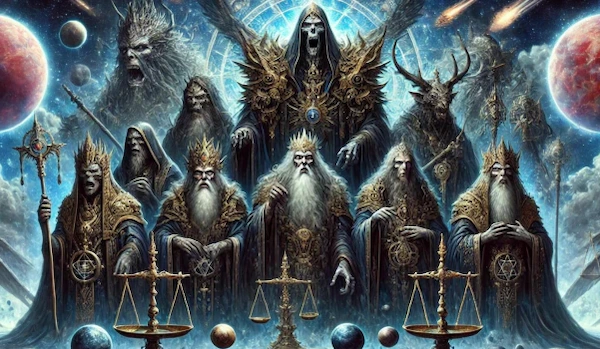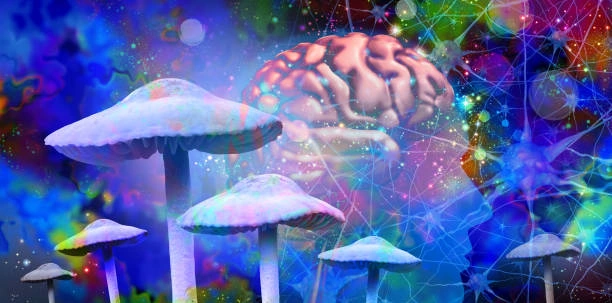
Introduction: The Cosmic Drama Unveiled
The Hypostasis of the Archons, also known as “The Reality of the Rulers,” stands as one of the most revelatory texts in Gnostic literature. Unearthed in 1945 among the hidden treasures of the Nag Hammadi Library in Egypt, this remarkable manuscript opens a window into an alternative spiritual worldview that challenged orthodox religious narratives of its time and continues to provoke profound philosophical questions today. Far from being merely an ancient curiosity, this text represents a radical cosmological framework that fundamentally reexamines the relationship between humanity, divinity, and the material universe.
The manuscript’s discovery—buried in sealed jars for nearly two millennia—symbolizes the very essence of Gnostic thought: hidden knowledge awaiting revelation to those prepared to receive it. Much like the divine spark that Gnostics believed lay dormant within human souls, this text remained concealed until the world was ready to engage with its challenging propositions about reality.
The Metaphysical Architecture: Philosophical and Spiritual Foundations
At the heart of The Hypostasis of the Archons lies a cosmological drama of extraordinary scope. The text articulates a sophisticated metaphysical system centered on the tension between transcendent spirituality and imprisoning materiality—a dualism far more nuanced than simple oppositions between good and evil.
The narrative introduces us to the Archons—cosmic rulers whose very name (derived from the Greek archōn, meaning “ruler” or “authority”) encapsulates their fundamental nature. These entities are portrayed not merely as malevolent beings but as tragically flawed cosmic powers, ignorant of their own limitations and origins. As the text poignantly states: “They [the Archons] do not know their own origin.” This ignorance is not incidental but constitutive of their identity—they embody the metaphysical principle of separation from divine wholeness.
This portrayal stands in stark contrast to the omniscient deity of mainstream Abrahamic traditions. The Archons represent a profound philosophical insight: power without wisdom becomes tyranny, and creation without self-knowledge produces suffering. Their blind wielding of cosmic authority without understanding its source creates a fundamentally compromised reality—our material world.
The text’s exploration of Sophia (Wisdom) adds another layer of metaphysical complexity. Unlike simplistic creation myths, the Gnostic account presents cosmic creation as an unintended consequence of Sophia’s desire for knowledge—her passionate quest to comprehend the ultimate depths of divinity. This “fall” of Wisdom into ignorance paradoxically becomes the catalyst for material existence. In this cosmic narrative, our universe emerges not from divine perfection but from divine curiosity gone awry—a philosophical proposition that resonates with existentialist concerns about meaning in an accidental universe.
This cosmological framework establishes a revolutionary spiritual epistemology: true knowledge (gnosis) is simultaneously dangerous in its pursuit yet essential for liberation. Unlike faith-based religious systems that emphasize belief in doctrine, Gnosticism positions experiential insight as the cornerstone of spiritual development. The text suggests that the universe itself has hidden certain truths from humanity—not as a test of faith but as a metaphysical condition to be overcome through awakening.
Cultural Reverberations: Influences on Gnostic Tradition and Beyond
The impact of The Hypostasis of the Archons extends far beyond its immediate historical context, establishing philosophical paradigms that would influence not only Gnostic thought but also resonate through mystical traditions across millennia. Its radical anti-materialism represents a fundamental critique of physical existence that challenges not just religious orthodoxy but the very foundations of how we perceive reality.
While mainstream Christianity eventually embraced Augustine’s declaration that creation is intrinsically good despite its fallen state, Gnostic traditions like that represented in Hypostasis propose a more radical position: material existence itself emerges from cosmic error and ignorance. This perspective anticipated later philosophical developments concerning the potentially illusory nature of physical reality—from Plato’s cave allegory to modern simulation theories.
More profoundly, the text transforms the very concept of salvation. Rather than redemption through vicarious sacrifice or adherence to moral codes, salvation becomes a matter of cognitive transformation—an awakening to one’s true nature beyond material constraints. This radical individualism in spiritual matters represented an existential threat to emerging religious institutions based on hierarchical mediation between humanity and divinity.
The text’s emphasis on self-knowledge as the path to liberation established a paradigm that would resurface repeatedly throughout Western esoteric traditions, from medieval mysticism to Renaissance Hermeticism to modern transpersonal psychology. Its assertion that external authorities cannot provide what must be discovered within oneself constitutes a perennial challenge to institutionalized spiritual authority.
Literary and Mystical Innovation: Unique Features in Gnostic Literature
What distinguishes The Hypostasis of the Archons from other Gnostic texts is its remarkable fusion of cosmological mythology with incisive philosophical inquiry. While works like The Gospel of Thomas present wisdom teachings in aphoristic forms, Hypostasis constructs an elaborate cosmic narrative that functions simultaneously as metaphysical exposition, spiritual allegory, and social critique.
The text’s literary strategy employs mythological narrative not merely as decorative storytelling but as a vehicle for conveying truths that transcend rational articulation. Its vivid personifications of abstract metaphysical principles—such as depicting ignorance as a cosmic ruler—transform philosophical concepts into dynamic characters within a cosmic drama. This approach makes profound philosophical insights accessible through narrative engagement rather than abstract reasoning alone.
Moreover, the text pioneers a form of hermeneutical resistance by reinterpreting familiar religious narratives (particularly Genesis) against their orthodox meanings. This subversive reading practice—finding hidden meanings that contradict surface narratives—establishes a template for counter-hegemonic interpretive strategies that would influence everything from medieval mysticism to modern literary deconstruction.
Perhaps most significantly, Hypostasis employs symbolic language that operates simultaneously on multiple levels: cosmological (describing the structure of reality), psychological (mapping the human psyche), and sociopolitical (critiquing power structures). This multi-dimensional symbolic framework allows the text to address existential questions about reality while simultaneously challenging both internal and external forms of oppression.
Theological Divergence: Comparisons with Canonical Religious Frameworks
When juxtaposed with mainstream religious traditions, the radical nature of The Hypostasis of the Archons becomes even more apparent, revealing fundamental differences in metaphysical assumptions that have profound implications for how we understand existence itself.
The Divine Nature: Creator or Impostor?
The Genesis account presents creation as a harmonious unfolding guided by divine wisdom: “God saw everything that He had made, and indeed it was very good” (Genesis 1:31). This affirmation of material existence as fundamentally blessed forms the cornerstone of Jewish theology, which celebrates embodied life through covenantal relationship rather than seeking escape from it. Similarly, Islamic tradition venerates Allah as Al-Khaliq (The Creator) whose craftmanship reflects perfect wisdom.
Hypostasis shatters this paradigm by suggesting that the self-proclaimed creator deity represents cosmic usurpation rather than legitimate authority. The material world emerges not from divine benevolence but from metaphysical error—a tragic misunderstanding that traps divine sparks within material forms. This perspective reframes suffering not as a mystery within divine goodness but as evidence of a fundamentally flawed creation requiring transcendence rather than mere redemption.
This theological inversion transforms how we might understand natural phenomena. While natural disasters in traditional theology present challenging questions about divine goodness (theodicy), in Gnostic frameworks they become expected manifestations of an imperfect cosmos governed by limited beings. The implications extend to how we might approach scientific inquiry—not as uncovering divine design but as mapping the architecture of cosmic limitation.
Anthropology: Fallen Sinners or Imprisoned Divinity?
Christian anthropology, particularly after Augustine, emphasizes humanity’s fallen nature: “all have sinned and fall short of the glory of God” (Romans 3:23). This perspective positions humans primarily as sinful beings whose redemption requires divine intervention through Christ’s sacrificial atonement. Human limitation becomes a moral category requiring forgiveness rather than an ontological condition requiring awakening.
Hypostasis proposes a radically different anthropology: humans contain divine essence trapped within material constraints. The human predicament stems not from moral failing but from metaphysical amnesia—forgetting one’s true nature. This perspective elevates humanity’s spiritual potential while simultaneously explaining existential alienation as the natural tension between our divine essence and material embodiment.
This anthropological revisioning transforms ethical frameworks from obedience to awakening. Rather than moral perfection, spiritual development becomes about remembering one’s divine nature. This shift anticipates modern psychological insights about self-actualization and authenticity as spiritual goals rather than mere rule-following or sin-avoidance.
Authority: Mediation or Direct Experience?
Traditional religious structures establish intricate hierarchies mediating between divinity and humanity. Priests interpret texts, sacraments provide grace, and doctrines define truth. These systems create elaborate external frameworks for authenticating spiritual experience and maintaining theological coherence across communities and generations.
Hypostasis dismantles these mediating structures by suggesting that true spiritual authority lies within individual consciousness. The divine spark within each person constitutes a direct connection to ultimate reality that requires no external validation. This radical democratization of spiritual authority threatened established religious institutions by relocating spiritual authenticity from external consensus to internal knowing.
This privileging of experiential knowledge over institutional authority resonates with contemporary spiritual movements that emphasize personal experience over dogmatic adherence. From modern mindfulness practices to psychedelic spirituality, the Gnostic emphasis on direct knowing continues to influence approaches that bypass traditional religious gatekeepers.
Eschatology: Final Judgment or Ongoing Liberation?
Traditional Abrahamic eschatologies present history as a linear progression toward cosmic culmination—whether Christ’s second coming, messianic age, or divine judgment. These teleological frameworks emphasize moral accountability within time-bound narratives moving toward definitive resolution.
By contrast, Hypostasis suggests a different temporal framework where liberation happens whenever an individual awakens to their true nature. This transforms eschatology from future cosmic event to present possibility—an “eternal now” where realization trumps chronological unfolding. Liberation becomes available in any moment rather than dependent on historical progression or divine timetable.
This reconceptualization of time itself challenges linear understandings of history and salvation. Rather than working toward future redemption, spiritual practice becomes about penetrating illusions that keep us locked in ignorance in the present moment—a perspective that resonates with Eastern contemplative traditions and modern mindfulness approaches.
Contemporary Resonance: Implications for Modern Thought
The ancient wisdom of The Hypostasis of the Archons continues to offer provocative insights into contemporary philosophical, psychological, and spiritual questions, demonstrating remarkable relevance across millennia.
Its critique of blind authority speaks directly to modern concerns about power structures and institutional control. By portraying cosmic rulers ignorant of their own limitations, the text provides a template for questioning contemporary authorities who may similarly lack self-awareness about their biases and boundaries. This framework offers valuable perspectives on everything from political systems to corporate hierarchies to religious institutions that claim absolute knowledge.
The text’s exploration of dualism remains relevant to ongoing environmental ethics discussions. While simplistic readings might suggest Gnostic hostility toward nature, deeper analysis reveals a nuanced critique not of the natural world itself but of our relationship to it when mediated through ignorance. This perspective invites ecological approaches that neither worship nor exploit nature but recognize both its beauty and limitations as expressions of cosmic principles.
Psychologically, Hypostasis anticipates modern understandings of how societal conditioning shapes perception. Its portrayal of Archons creating a false reality parallels contemporary discussions about how language, culture, and power structures shape our understanding of ourselves and our world. The Gnostic call to see beyond these constructs resonates with modern critical theory’s attempts to unveil hidden assumptions controlling social discourse.
Most profoundly, the text’s emphasis on self-knowledge as the path to liberation speaks to contemporary searches for authentic identity amid commercial and social pressures toward conformity. Its suggestion that true selfhood transcends social roles and material limitations offers a framework for addressing modern alienation and existential anxiety.
Spiritual Illumination: Key Teachings from the Hypostasis
The wisdom distilled from this remarkable text continues to offer spiritual guidance through its profound insights:
“The Archons are the powers of the world”
This statement penetrates beyond simplistic good-versus-evil narratives to identify how structural forces—political, economic, cultural—shape human consciousness and experience. It challenges us to recognize how external systems become internalized limitations, restricting our perception of possibilities beyond conventional frameworks.
“They do not know that they are not the ultimate reality”
This profound observation applies not merely to mythological beings but to any system of thought that mistakes its partial perspective for absolute truth. It reminds us that all human knowledge systems—religious, scientific, philosophical—remain limited approximations rather than final articulations of reality.
“The true man is a stranger to the material world”
Rather than advocating escapism, this insight points toward the existential alienation that arises when we awaken to dimensions of consciousness that transcend material explanations. It validates the common human experience of feeling “not at home” in conventional reality—recognizing this not as pathology but as the first awakening to wider possibilities.
“The light that is within you can guide you past the Archons”
This teaching locates spiritual authority within individual consciousness rather than external sources. It suggests that authentic guidance comes not from following others’ maps but from cultivating inner illumination—developing discernment that can navigate between competing truth claims based on resonance with inner knowing.
“The world is a prison for those who do not know themselves”
Perhaps the text’s most profound insight, this statement reframes liberation not as escape from physical reality but as transformation of perception through self-knowledge. It suggests that the same world experienced through different consciousness becomes either prison or playground—with awakening transforming limitation into opportunity.
Conclusion: Ancient Wisdom for Contemporary Seekers
The Hypostasis of the Archons represents far more than an historical artifact or theological curiosity. Its revolutionary propositions about reality, authority, knowledge, and human potential continue to challenge conventional frameworks and inspire alternative approaches to existence’s fundamental questions.
By questioning the ultimate legitimacy of material existence itself, the text opens space for reconsidering our relationship with embodiment, nature, and physical limitation. By locating divine essence within human consciousness, it elevates spiritual potential beyond institutional boundaries. By identifying ignorance rather than sin as humanity’s fundamental challenge, it transforms spiritual practice from moral perfection to perceptual awakening.
For contemporary readers willing to engage with its challenging perspectives, this ancient text offers not merely historical insights into alternative religious movements but a compelling invitation to question our most basic assumptions about reality itself. Its enduring value lies not in providing definitive answers but in asking questions that continue to resonate across centuries—questions about authority, embodiment, knowledge, and liberation that remain as relevant in our technological age as they were in the ancient world.
The enigmatic wisdom of The Hypostasis of the Archons continues to whisper across millennia, inviting each new generation to reconsider the fundamental nature of existence and humanity’s place within cosmic mystery. Its persistent challenge—to look beyond apparent reality to deeper structures of being—remains an essential counterbalance to both religious dogmatism and scientific materialism, offering a third path of mystical insight that honors direct experience over inherited belief.
Some Meaningful Quotes From the Hypostasis of the Archons
<<The Archons are the powers of the world>>
This quote identifies the Archons as governing forces in the material world. They are often seen as obstacles to spiritual enlightenment, representing the limitations imposed by societal structures and material existence.
<<They do not know that they are not the ultimate reality>>
This statement suggests that the Archons lack understanding of their true nature and role. Their ignorance of a higher reality leads to oppression and the perpetuation of worldly suffering, indicating that true knowledge transcends their authority.
<<The true man is a stranger to the material world>>
This quote reinforces the idea that genuine identity and essence lie beyond physical existence. It implies that individuals should seek to understand their spiritual nature rather than being defined by worldly ties and material desires.
<<The light that is within you can guide you past the Archons>>
This line emphasizes the presence of an inner divine spark or light that can lead individuals to liberation from the Archons’ influence. It encourages reliance on inner wisdom and spiritual insight for personal empowerment and freedom.
<<The world is a prison for those who do not know themselves>>
This statement underscores the importance of self-knowledge. It suggests that a lack of understanding of one’s true self can lead to a life bound by the limitations of the material world, perpetuating a cycle of ignorance and suffering.
The Gnostic Texts Series
1. The Gnostic Gospels: Why Are They Interesting From a Spiritual Perspective?
2. Cosmology and Spirituality in The Book of Enoch
3. Sophia of Jesus Christ: Feminine Divine Wisdom in Gnostic Thought
4. Pistis Sophia: Gnostic Insights into Knowledge and Spirituality
5. The Apocalypse of Peter: Gnostic Insights on Morality and Judgment
6. The Nature of God in the Apocryphon of John: A Gnostic Interpretation
7. Spiritual Dualism in the Second Treatise of the Great Seth
8. Materiality and Spirituality in the Hypostasis of the Archons
9. The Tripartite Tractate: Bridging Gnosticism and Hellenistic Thought
10. Contrasting Beliefs: The Gospel of Thomas vs. Canonical Texts
11. The Gospel of Mary: Feminine Authority in Gnostic Spirituality
12. The Gospel of Truth: The Conception of Christianity According to Valentinus
13. The Gospel of Philip: Mary Magdalene’s Role and the Meaning of Sacraments
14. The Exegesis on the Soul: A Subversive Journey of Spiritual Restoration
15. The Thunder, Perfect Mind: Paradox and Divine Femininity in Gnostic Wisdom
16. Sethian Texts and the Alchemical Transformation of Consciousness
ARE YOU A TRUE SPIRITUAL SEEKER?
Read the sentences below and choose the ones you most agree with.
Determine the number of selected boxes and check the corresponding profile.
0: You are an authentic spiritual seeker
1-2: You are a growing spiritual seeker
3-4: You are a disoriented spiritual seeker
5-6: You are by no means a spiritual seeker
Further details about spiritual seeking





